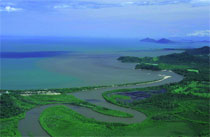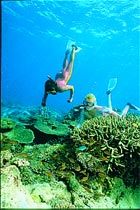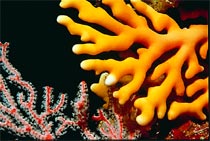|
Great Barrier Reef
The Great Barrier Reef stretches for more than 2000km along the north-east coast of Australia. Comprising more than 2900 reefs, some 940 islands and surrounding waters, the Great Barrier Reef is the largest natural feature on the earth.
Covering over 348 000 km2, the Great Barrier Reef World Heritage Area (GBRWHA) was internationally recognised as being a unique area of outstanding value to humankind and a jewel in the crown of the world's natural wonders. |

|
|
|
|
|
While the coral reefs initially made the Great Barrier Reef famous, the area also comprises:
- mangrove estuaries
- sandy and coral cays
- continental islands
- seagrass beds
- algal & sponge 'gardens'
- sandy or muddy seabed communities
- continental slopes and deep ocean trenches
|
 |
| |
|
| 
All Images courtesy of the Great Barrier
Reef Marine Park Authority
|
The Great Barrier Reef provides habitats for a wide variety of marine-based plants and animals. The Reef is home to approximately:
- 1500 species of fish
- 360 species of hard corals
- one-third of the world's soft corals
- 4000 species of molluscs (eg. shells)
- 1500 species of sponge
- 800 species of echinoderms (starfish, sea urchins, etc)
- 500 species of seaweed
- 23 species of marine mammals
- 6 species of marine turtles, all listed as rare or threatened
|
|
Next - Pressure on the Great Barrier Reef |
|